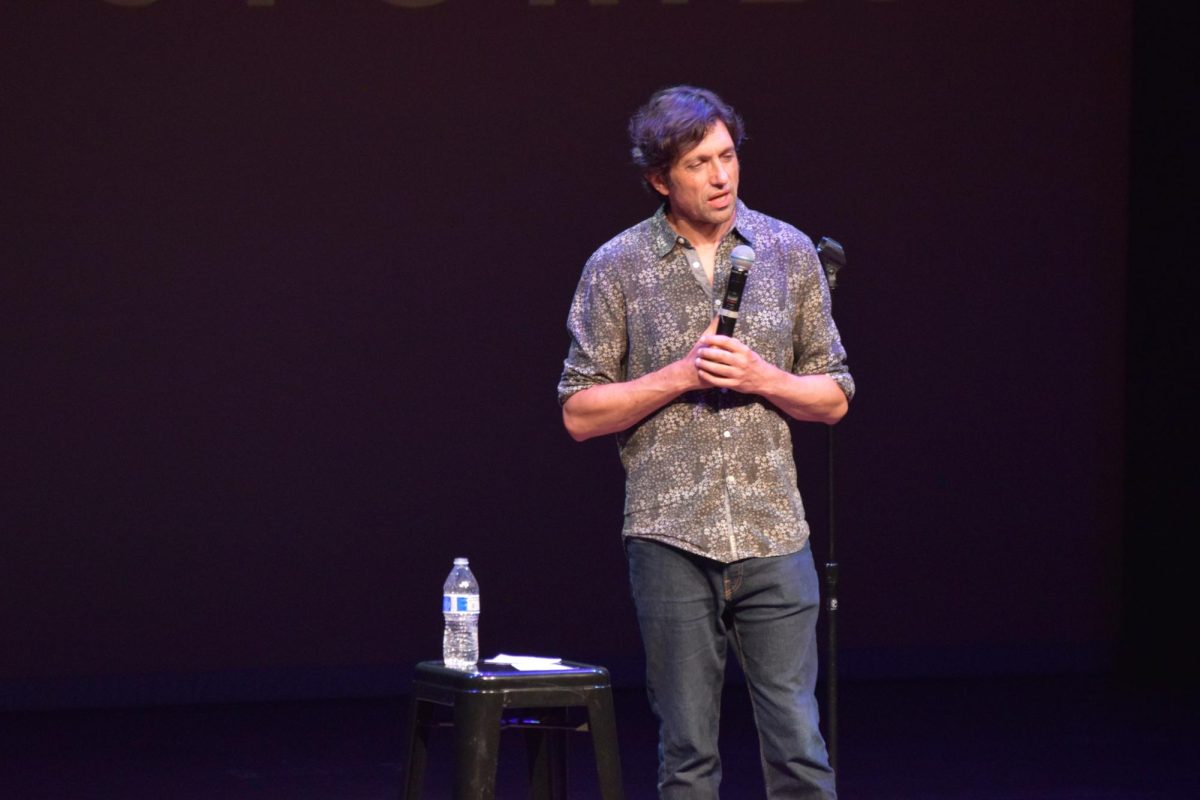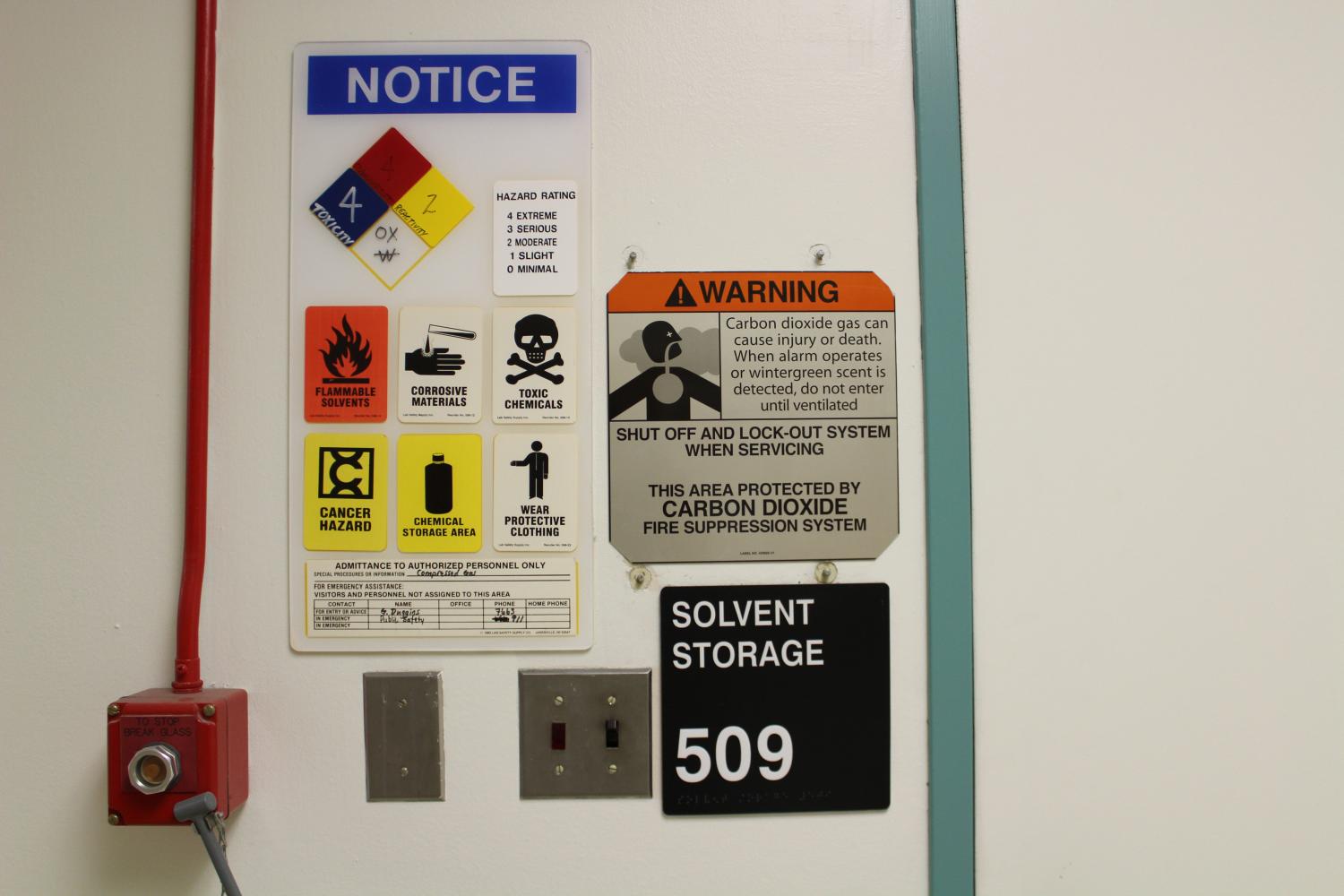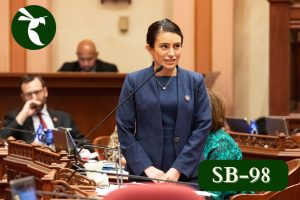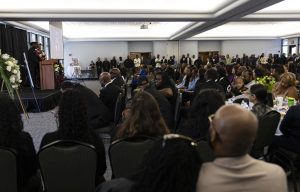BREAKING: Audit of CSU finds health and safety oversight inadequate
Claire Morgan – The State Hornet
After a hazardous chemical spill, the fourth and fifth floor chemical storage rooms in Sequoia Hall were part of the subject of a state health and safety audit of four California State University campuses. The audit, released Tuesday, found that the campuses have not complied with health and safety policies, training and proper laboratory inspection.
April 24, 2018
An audit by the California State Auditor’s office has found that the California State University system has not provided acceptable safety measures for students and employees working with unsafe chemicals.
Both the CSU Chancellor’s Office and selected campuses — Sacramento State, San Diego State, Sonoma State and CSU Channel Islands — were audited after four state legislators made a request in June 2017, citing what they called a “disturbing trend” of threats to student and employee health.
The request to audit Sac State was made following two 2016 events: a hazardous chemical spill as well as the discovery of excess lead in drinking water.
The spill and improper chemical storage practices may have caused some employees to become infertile, according to several current and former employees. Affected employees filed a lawsuit against the University in September.
The audit found that the four campuses that were reviewed “did not consistently comply with requirements related to the oversight of health and safety policies, training, and the inspection of laboratory safety equipment.”
Sac State criticized for inadequate safety
The audit found that Sac State does not have a chemical committee that oversees the handling of chemicals on campus, and the committee that is supposed to oversee those issues does not meet frequently enough or talk about chemical handling enough.
[su_document url=”https://statehornet.com/wp-content/uploads/2018/04/2017-119.pdf” height=”1000″]Blank application form. [/su_document]
“In 2006, Sacramento combined its chemical committee with its Campus Safety Advisory Committee to form a campuswide safety and environmental health committee,” the audit states. “However, the new committee does not meet regularly and the meeting minutes do not reflect meaningful and regular discussions on chemical hygiene.”
Senior Director of Risk Management Services Gary Rosenblum said that the chemistry department has been holding chemistry safety meetings throughout the audit process, and reports to the campus-wide executive safety committee.
Rosenblum said that the Department of Natural Sciences and Math has incorporated new systems for a new safety committee for the entire department, in addition to the chemistry department safety committee. He said that there will be more safety committees on campus as well.
“The executive safety committee is for campus-wide issues,” Rosenblum said. “So we rely on the chemistry department and (the natural sciences and math department) to manage their own safety issues. If there are things that they uncover that are useful for the campus in terms of safety learning or information regarding anything that happens over there or programs they develop, they can run that through the executive safety committee — that’s the new format.”
Sac State has also not updated its chemical handling plan in 15 years — a task which would have been performed by the chemical committee. The chemical plan has also not been audited, which is required to be performed yearly as mandated by law.
The chemical plan mandates that its departments must complete self-audits every semester, but the biology department failed to do this. Sac State’s chemical plan does not indicate what campus group is responsible for its oversight.
“Sacramento’s senior director of risk management services stated that despite the missing information, he believes that the (environmental health and safety) office has this responsibility,” the audit states. “However, unless Sacramento clearly identifies the entity responsible for implementing and overseeing the chemical plan, it risks that its plan may not adequately safeguard the health and safety of employees and students.”
The audit recommends that Sac State revises its chemical plan by January 2019.
The audit found that Sac State did adequately train all audited employees in laboratory safety, but did not adequately train three of five audited employees in hazardous waste management. It also found that Sac State did not train its employees about bloodborne pathogens.
Sac State also did not provide the required documents that showed that students were made aware of laboratory safety information when taking a course that required them to handle dangerous chemicals in four of six classes surveyed.
Sac State does not flush its eyewash stations and showers at least once a month, which is mandated by state regulation. The audit found that these safety measures are not accessible enough to be effective.
“When we visited a Sacramento art sculpture lab in which students could use potentially dangerous materials, we found that if someone required an eyewash, he or she would need to go down a flight of stairs and through a bathroom in order to access that equipment,” the audit states. “Further, if the bathroom door was locked, the person would need to go outside of the building, traverse two additional flights of stairs, and use another entrance in order to access an eyewash.”
The audit found that Sac State did not consistently post warning signs at the entrances of rooms about the possibility of the presence of asbestos.
The audit also found that Sac State appropriately responded to the discovery of lead in the drinking water, citing the shutdown of one fountain that had particularly high lead levels and the ASI Children’s Center fountains.
Rosenblum said that his department gave the auditors the same safety training they would give a new employee to show them how employees are trained at Sac State.
“They are not professional safety experts; they are auditor experts,” Rosenblum said. “A lot of the findings were their editorial opinion on what the meaning of their findings was. I thought it was fair, but they create the idea that there is — in some instances — a lack of safety because a document is not present, or because we didn’t have a certain item that was checked on schedule because it was a little bit late.”
Chancellor’s Office doesn’t hold campuses accountable
The audit found that the CSU Chancellor’s Office has not been active enough in ensuring that campuses have “policies and processes” in place protecting those that work with hazardous materials. It also found that the Chancellor’s Office has not made sure schools are submitting annual reports that are required regarding health and safety programs.
Many of these issues have been happening for nearly 20 years. The audit found that this is the fault of the Chancellor’s Office because it hasn’t taken the steps the auditors felt were necessary in holding campuses accountable.
The audit committee included CSU President Timothy White’s response to the findings of the audit in the final report.
In the letter, White said that he is planning on taking steps to improve health and safety at the CSU, including mandating safety audits at all campuses starting in 2019.
White also objected to several portions of the audit committee’s findings, including the finding that safety committees are required to meet regularly.
“Specifically, we do not agree that the safety committees are required as part of the CSU Collective Bargaining Agreement with the State Employees Trades Council,” White said in the letter. “The agreement allows for the establishment of these safety committees, but does not require them to meet regularly. Instead, the agreement states that the safety committees shall meet on a monthly basis or by mutual agreement.”
CSU Employees Union President Neil Jacklin said that the issues with CSU-wide health and safety are not due to a lack of funding.
“The CSU is currently holding at least $2 billion dollars in outside accounts which could have been used to protect the health and safety of employees and students,” Jacklin said in a press release. “The state needs to hold the CSU accountable for its disregard of the health and safety of employees and students, and to enact statutes that provide meaningful state oversight and accountability of the CSU’s operations and budget.”
According to CSU Public Affairs Manager Liz Chapin, the reserves are meant for “unexpected” costs — not system-wide issues.
“CSU’s reserves are savings accounts and are meant for unexpected cost increases, loss of revenues, future planning and long-term goals,” Chapin said in an email to The State Hornet. “They are meant for one-time expenses only—such as emergencies, natural disasters, one-time educational or capital projects, academic program start-up costs, and other one-time expenditures.”
Three other campuses audited
CSU Channel Islands was fined $18,300 for two incidents. The first was for not posting a warning sign on an air compressor that could injure employees to warn them that the compressor is automatically controlled and may start at any time.
The second incident was when an employee was sprayed with hot water receiving second and third degree burns after a hot water pipe was not relieved of internal pressure. A valve briefly opened which resulted in the injury.
The campus also had no documentation for annual reviews of their chemical plan’s effectiveness and there were also no regulations on self audits.
A mechanical room on the campus was supposed to have had signs indicating the presence of asbestos or material presumed to contain it and no documentation could be found for a full year.
Between 2012 and 2017, San Diego State was fined a total of $17,600 for eight separate incidents. The issues included not reporting breakdowns in a generator, a gas flow meter and a gas turbine engine. In 2015, the school received its largest fine — $10,000 — when it installed a gas turbine engine without submitting an application.
The audit also noted that the school had routinely failed to inspect all of the emergency showers and eyewash stations. The school also did not conduct regular inspections of “critical safeguards” such as fire extinguishers, emergency eyewashes and showers.
Four of the five lab employees reviewed at the campus were not trained in proper hazardous waste handling techniques and general laboratory safety.
Sonoma State also failed to routinely inspect emergency showers and eyewash stations, and failed to inspect any of the 17 engineering controls selected for more than three years.
The audit also found that Sonoma State’s chemical plans may not align with its current practices, which can increase the risk of its employees health and safety.
All five of the Sonoma State employees audited were found to have not been trained in hazardous waste, while four of five audited employees did not receive training as frequently as they needed to in laboratory safety. The fifth employee in that study did not receive any training at all.
Sonoma State was fined $2,240 for not determining if an employee who was leaf blowing gutters was exposed to lead. The audit also found that the school failed to ensure that all surfaces at that employee’s worksite were free of lead.
Sonoma State was also fined $2,400 because it did not determine the amount of areas and materials that could have contained asbestos. It also did not post warning signs, and did not provide employees working in those areas asbestos training.

























































































































